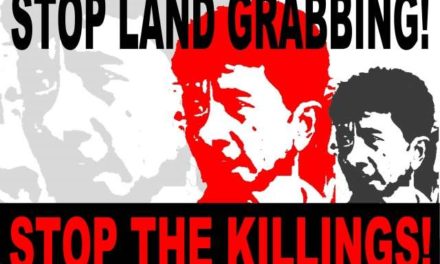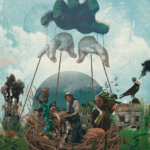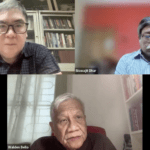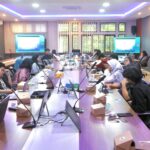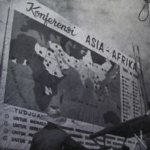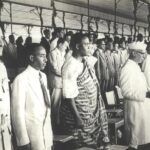Pure sadness. On the plane from Paris to Tel Aviv last Wednesday, that was the feeling overwhelming me as I thought about the reality of witnessing the Israeli-Palestinian conflict at first hand.
Personal memories come back: those of friends from my schooldays in Morocco who, in the 1960s, had emigrated en masse to France, Argentina and Canada but also to Israel.
Also, a vague feeling of political responsibility haunts me: Zionism and Israel weren’t born out of the Nazi genocide, any more than they were born out of simple religious identification. The lay definition of Jewishness is different from the religious one and, in many ways, closely related to the workers’ movement and democracy. Moses Hess, the forerunner of Zionism, sympathised with Marx and, like him, had his roots in left-wing Hegelianism. And it was Jewish officers from the Red Army who, after 1945, trained the haganah, Israel’s first defence organisation.
But the sadness came above all from the feeling that we had reached a total deadlock. According to the newspapers, it seemed certain that Sharon would, sooner or later, be obliged to leave the occupied cities but, clearly, the suicide bomb attacks would then resume, followed by reprisals and, most likely, by new Israeli occupation.
INTERNATIONAL MISSIONS
The trip had been decided the day before, when ATTAC learned that a delegation — under the banner of the “International Council of the World Social Forum of Porto Alegre” — was being assembled with a strong Brazilian contingent together with European, American and Asian militants. This was an opportunity to join the international solidarity movement which was coming together spontaneously in this moment of crisis.
In many countries, delegations have been put together in recent months to go “on the spot” in Israel and in Palestine: delegations which, in France, have been called “civil delegations for the security of the Palestinian people”. So it was that nearly 400 militants made the trip every week last Christmas, other teams went to ensure a permanent presence and, at Easter, around 600 militants from many countries were on the spot when the Israeli army launched its offensive against the Palestinian towns.
In Europe, everyone saw the television coverage of Jose Bove going into Arafat’s headquarters but few recognized those who accompanied him. There was Mario Lill, leader of the landless movement of Rio Grande do Sul (Brazil), who represented the MST at the June 2000 Geneva conference, the one which launched the Porto Alegre World Social Forum process. There was also Paul Nicholson, a Basque militant from the Emen Eta Mundua (EHNE) anti-globalisation movement who had been present at all the milestone initiatives, from Genoa to Barcelona via Porto Alegre but, above all, known for being one of the founders of Via Campesina. Many militants from this growing global movement were to be seen with them: several members of ATTAC are still in Arafat’s headquarters and it is leaders of the “Genoa Social Forum” who have stayed for days and days at the hospital in Ramallah, later relieved by Greek militants from the movement who had organised the mobilisation for Genoa.
There were many Europeans in Ramallah but even more Americans in the group of around a hundred militants in Bethlehem the day the city was invaded. Waving white flags, the militants accompanied the Palestinian ambulances to prevent them from being targeted by Israelis and “protected” the city’s refugee camp, gaining precious days before the troops broke in.
Rory, a 30-year old Scotsman present in Bethlehem for more than ten days, is a good example of what these new militants are like. He’s a business lawyer in a London partnership for six months of the year and this allows him to earn enough money to do something else the rest of the time. Rory had been involved in the campaign for the cancellation of Third World debt, but with no strong links to Palestine. However, after seeing documentaries on the Palestinians’ situation and hearing Edward Said, the great Palestinian-American intellectual, he decided to join an “International Solidarity Movement” delegation, the American equivalent of the civil missions, which the Palestinian militants launched a few years ago. Two days later he was on a plane to the West Bank, but not before buying a small digital camcorder and, on arrival, making contact with members of the press. As a privileged witness, his reports made the front page of the main Scottish newspaper and he’s in regular contact with the BBC and CNN.
Without any major public appeals or campaigns, we are seeing an entire generation joining up with the small core groups which, for years or even decades, have been maintaining solidarity work with the Palestinians.
The global movement that has been developing since Seattle was able to connect to the pacifist movement during the war in Afghanistan. Now it ‘s playing a significant role in the emergence of a sort of international civic conscience which intends to make itself heard everywhere it can, including during armed conflict. For many of these militants, it is no longer a matter of taking up the fight alongside combatants and revolutionaries, but of being present, peacefully, to bear witness, to build room for democracy and to try to limit, through the presence of international observers, the suffering inflicted by the armed forces.
IN ISRAEL
The customs and police formalities go without a hitch, because I have the address of a friend to see in Israel which allows me to answer the extensive questioning on why I’m making this trip. All the militants who arrive as a group are automatically expelled, as are those whose arguments are not deemed sufficient: around a hundred people have thus been refused entry into Israel in recent days.
Immediately on Wednesday evening, an opportunity arose to see Michel Warshawsky. Michel is “the” anti-Zionist Israeli militant, he’s always been alongside the Palestinians. He’s the one everyone calls “Mikado”.
He tells how Via Campesina got involved in this struggle. A meeting that took place at the end of January in Porto Alegre, between Palestinian and Israeli militants and Via Campesina leaders enabled a delegation to be put together for Palestine on the “day of the earth” event to establish direct contacts with rural workers in the occupied territories. That was the day tanks rolled into Ramallah.
Above all, he talks about the situation on the Israeli side.
The situation is very bad, and not just because, as in any war situation, the immediate reflex is to close ranks, nor because of press self-censorship which gives Israelis a totally biased view of what is going on: extensive coverage of the funerals of the victims of suicide attacks and the families the victims leave little room for the brief reports on the West Bank, leaving the impressions that the situation has been “normalised”.
The crux of the problem is the interpretation of the failures of Camp David and Taba as provided by Ariel Sharon and, above all, before him, by Ehud Barak, his labour party predecessor. Supposedly, during these negotiations, Yassir Arafat and the Palestinian leaders refused a Palestinian state in the Gaza Strip and the West Bank. This refusal, plus the suicide attacks against civilians in the very heart of Israel, is supposed to prove that the Palestinians’ real aim, contrary to their claims, is not the creation of a nation state in the territories occupied in 1967, but the destruction of Israel. That is what lies behind Sharon’s declarations that amaze foreign observers but are highly effective within his country as he talks about “the survival of the Jewish people”. The fact that this version comes from a “left wing” prime minister and that the labour party stays in the government coalition lends a lot of credibility to this thesis, just as the fire attacks on synagogues, such as have happened in France, are used as proof that there’s a fresh upsurge of anti-Semitism worldwide. In such a climate of paranoia the many international condemnations carry little weight or even reinforce the idea that this really is a decisive battle for “the Jewish people”.
It is therefore very important to remember the negotiation terms at the time. Far from handing back all the territories, Ehud Barak’s government meant to keep the colonies closest to the border, even being prepared to “exchange” those for a piece of desert, together with East Jerusalem of which only a small neighbourhood in the outskirts would have been returned to the Palestinians. Nothing was said about what is perhaps the thorniest problem: the Palestinian refugees dating back to 1948, or even the 200,000 who live in the Lebanon in the most difficult circumstances.
JENIN
As in all situations of conflict, or when major events occur, there are always one or a few hotels where “everyone” — journalists, politicians and various leaders — meet and swap the latest news. In this case the crisis and its international repercussions are so serious that there are four strategic sites: the New Imperial in the old town, the least expensive where one finds the militants, the Jerusalem, previously called the King David, the most exclusive, where one can see Zinni, the American negotiator and the leading reporters (who can also be found at the American Colony) and, finally, the Ambassador Hotel, a middle-level establishment, where the parliamentary delegations and many journalists hang out. These are the places where you can meet those who are responsible for making contacts with Palestine and preparing visits and that’s how, on Thursday morning, I came across Leo Gabriel, an Austrian friend, who’s a militant from ATTAC Austria and the “European March against Unemployment” but also a journalist with Austrian state television. He has a car going to the Jenin region and I decide to go with him because the news coming out of the refugee camp in the city there is particularly alarming.
Jenin is right in the north of the West Bank. The surrounding Israeli area is inhabited by many Arab villages where some of the refugees in the Jenin camp come from: they first arrived during the 1948 exodus which the Palestinians call “nakbah”, the catastrophe. Two things are immediately striking as soon as you pass into the West Bank. The first is the amazing jigsaw puzzle of territories and peoples. With a few contacts, it is easy to move between Israel and the West Bank and at any time, in the middle of the occupied territories, you can come across an Israeli colony. So, unlike in the Gaza Strip where there are far fewer colonies, the idea of a “wall” that would isolate the occupied territories from Israel seems highly hypothetical, unless the 200,000 inhabitants of the colonies are to be abandoned.
The second striking feature is the total solidarity between Palestinians. We spent the whole of Thursday in the occupied territories, between Jenin and Nablus, the zone which is considered by the Israeli army as being the most dangerous and which is therefore the most closely-watched and controlled. At no time, apart from when we returned to Israel, were we stopped or controlled at a checkpoint. Our guide kept checking with the inhabitants, young or old, whether the army was down the road and if we could get through. In front of us there was a taxi which stopped at each dangerous bend, using his mobile phone to check with someone in the vicinity on whether there were snipers in the area or whether there was a military blockade controlling traffic.
The stories coming out of Jenin are dreadful. We aren’t able to go into the actual camp which was home to more than 13,000 inhabitants and from where we could still hear the sound of automatic gunfire but, in Taybeh and Rumanah, two outlying villages, we met many refugees who had just arrived. All were men, around 200 at Taybeh and 450 at Rumanah, the women and children were in other villages. Many have the same story to tell. Many houses have been destroyed by missiles fired from helicopters or tanks, most of the men were arrested, held in detention for 2 or 3 days in hard, humiliating conditions, their wrists so tightly bound that some still show vivid scars, their eyes blindfolded, unable to go to the toilet. After that, there were dropped off miles from Jenin with strict orders not to go back there and they came to these villages without having any news of their families.
Some of them bear witness to atrocities committed by the army. In Rumanah a youth of about 15 claimed to have witnessed summary executions and to have seen many corpses in the streets. In Taybeh, Kassim Salah, a 38 year-old father of four claimed soldiers used him as a human shield for two days: he had to go into the houses and narrow streets first to “protect” the Israeli soldiers. During those two days he witnessed the death of four young men who were moving forwards with white flags and who were slaughtered by the soldiers.
RAMALLAH
Friday, the “World Social Forum” delegation comes together, most of the Brazilians, including a parliamentary delegation, have arrived. Milton Temer is the member of the federal parliament who represents the Workers’ Party in the delegation. We link up with two women, an American and a British member of the “International Solidarity Movement”, and a Belgian delegation which includes the president of the Senate socialist group, and decide to go to Ramallah to visit the hospital and try to meet the militants who are in Yassir Arafat’s headquarters.
We’re now used to going into Ramallah: a car drops off the “visitors” on a road near the checkpoint, we go a few hundred yards on foot and then we can get taxis into the city. On arrival at the hospital, we meet the wounded and talk to the medical staff who show us the communal grave they’ve had to dig in the courtyard.
The hospital is at the entrance to the city and the tanks aren’t there, some children are playing in the street and just occasionally, an adult takes a quick glimpse outside. But the curfew hasn’t been lifted: it was for a few hours the day before but today going out into the street is totally forbidden. The group discusses the idea of a demonstration. Given our low numbers, less than a twenty, the term “delegation” would probably be more appropriate. There are three television crews ready to accompany us and Colin Powell has just landed in Israel: we think we can try this without running too much of a risk.
We set off, equipped with white flags. Walking slowly, so that it is quite clear that our intentions are peaceful, but also because we often have to stop: first, a hundred meters after the hospital, to accompany an old lady who’s too frightened to go there on her own.
After 500 meters, we reach the centre. There, there’s neither man nor beast, quite literally. The sight of the city centre is staggering: it’s totally deserted but we know that all the inhabitants are there, hiding behind their lowered iron shutters. A Canadian from the “Alternatives” movement who was there the day before, just as the curfew was lifted so that the inhabitants could go out for a few hours, told us that it was like springtime in Quebec: snow in a dead and deserted landscape and then, a few days later when the snow melts, life bursts out. Here, we have to remember that the inhabitants have been holed up in their houses for more than two weeks!
The tanks are in the main square, with a few soldiers who train their guns at us. This is rather a frightening moment. Then we walk on, up to the presidential palace, about a kilometer further on. It’s already a miracle that we’ve got this far. But the miracle comes to an end, the soldiers arrive with a tank, we negotiate to get an interview with our friends, unsuccessfully. We phone Theo, a friend of a friend, who lives there and who writes an hour-by-hour column on the West Bank situation which is widely published by email. We go back to the hospital and we hear isolated gunfire from another district and shellfire from a tank. A few hours later we’ll learn that a youth was shot down that morning.
WITH THE ISRAELI PACIFISTS
On Saturday a large coalition of Israeli, Arab and Jewish militants decided to demonstrate in front of the entrance to the Jenin camp, along the main road, accompanying trucks bringing supplies of food, clothing and blankets.
The demonstration is a significant success: 3000 people took part from different villages around Israel. At the head of the procession were young Arabs, full of emotion and hoping to reach their objective, to see their families and loved ones. Then came a mixed procession with pacifists, different left wing political groups and a lot of young people. A small group of teenagers comes together, wearing t-shirts with a yellow Star of David, with the word “Palestinians” in the centre. They’ve decided, in order to touch Israeli public opinion, to call themselves “don’t touch my holocaust”. This group explains to us how they started to take action when they learnt that, ten days earlier, foreign militants had defied the curfew and paraded through Ramallah: this inspired them to act. We were also able to test out the impact of these activities on the territories in East Jerusalem where several people we met in the streets knew that demonstrations had been held in Ramallah.
The army tries to stop the demonstration with a Jeep and a few soldiers. Given the numbers and the level of determination, they let us through.
One incident gives a good insight into the true nature of the Israeli army. The demonstration passes in front of Salem, a big military camp where many Palestinians have been and still are detained. About twenty soldiers are deployed behind the railings. The demonstrators chant, in Hebrew, “corrupt occupation”, “the refuznicks (the soldiers who refuse to serve in the occupied territories) are heroes”. On hearing that, a soldier, probably a reservist given his age, jumps up and down and starts waving his arms around to show his total support; his commanding officer arrives, gives him a good telling-off, and then goes away again. The soldier continues to gesture his support, but a little more discretely. A few minutes later, another soldier goes crazy and wants to go out and insult the demonstrators or maybe even fight them. The officer intervenes again and several of them calm the soldier down and prevent him from going outside. That’s all. An army that’s as popular and “democratically” run is probably very strong in defending its country when attacked but, on witnessing this scene, one has a better understanding of why soldiers have targeted journalists or how atrocities could have been committed.
Finally, the demonstration is brought to a halt a few kilometers further on at the official checkpoint before Jenin. An agreement is reached with the organisers: the soldiers guarantee that the trucks can pass through if the demonstration disperses. The next day we’ll learn that only six of them were able to go in and that they had to unload their goods quite far from the camp, without really knowing whether they’ll reach the people they were intended for.
Around a dozen of us leave, together with the Brazilians, and we go back into the occupied territories, into Taybeh, to do some interviewing and hear from some witnesses.
Sunday morning provides an opportunity to meet some pacifist militants in Tel Aviv. There’s a team from Indymedia Israel which is very active, publishing a magazine and streaming videos and a radio on the web, there’s an Israeli trade union militant who’s close to the communist party, and there’s Mikado.
All have decided to mobilize in priority against the occupation of Palestinian cities and we discuss how to share information and work together. At midday there’s a press conference in Jerusalem and, that same afternoon, it’s back to Paris with seven militants from civil missions who have just been expelled from Israel.
* Christophe Aguiton is a member of the international bureau of ATTAC France


